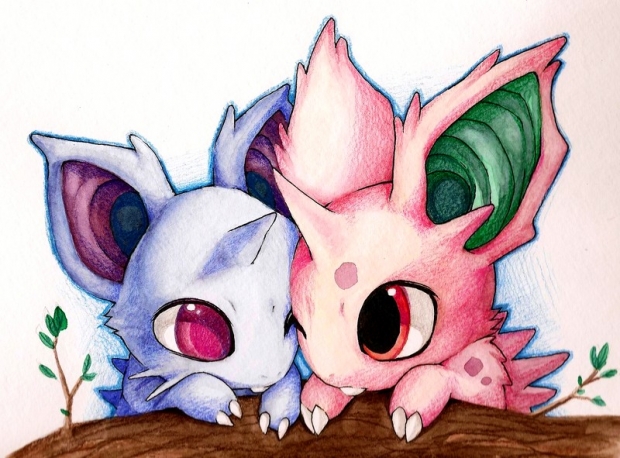The Pokemon games sure have come a long way since the days of Generation One. Not only have been a whole lot of new Pokemon added since that time, but several other elements as well. But even back in the days of the first generation, there was one Pokemon that one could say was the first in what is now a very common concept. Presenting this week’s Interesting Specimen, Nidoran.

I have to admit, these weird hamster/rabbit/porcupine creatures, and their respective evolved forms, are some old favorites of mine, especially Nidoking. But the reason why Nidoran has landed in the Interesting Specimen category is because it was the first Pokemon to have defined genders. There was no breeding of Pokemon before Generation Two, so most Pokemon captured in the original Gen. One games did not have a known gender. But the Nidoran species was a very notable exception.
In fact, Nidoran wasn’t only the first Pokemon to have known genders; it was the first Pokemon to have distinct physical differences due to their gender. The male of the species is pink and has a distinct horn on its forehead, while the female is blue and has a very small horn. This sort of thing is present with animals in the real world, such as deer for example. Anyway, the Nidoran species is also the very first Pokemon to have different evolved forms based on their gender. The male evolves into Nidorino, and later into Nidoking, while the female of the species evolves into Nidorina, and later into Nidoqueen. So in a way this Pokemon was pretty ahead of its time.
In the Games: In Generation One, Nidoran of both genders can be caught fairly early in the game. In fact here’s a tip for those of you playing one of the original Gen. One games. If you’re playing Yellow or have chosen Charmander as your starter, it might be a good idea to pick up and train a Nidoran before facing the first gym, as they learn Double Kick fairly quickly. I’m not sure if that’s still the case in the remakes though. Anyway, Nidoran, as well as Nidorino and Nidorina, can also be captured in Kanto’s Safari Zone.
In Gen. Two, Nidoran can be captured in a few of the routes in Johto, as well as some of their old Kanto locations if memory serves me. Moving ahead to Generation Four, Nidoran, and I believe Nidorino and Nidorina can be caught on Sinnoh Route 221 using the Poke Radar. As for Gen. Five, the only place to find Nidoran in White is in White Forest, and in one of the Hidden Grottos in Black 2 and White 2. And of course, the only way to get Nidoking or Nidoqueen in the games is to evolve Nidorino or Nidorina. But that’s easy enough to do.
Evolution: This is where the differences in gender become even more pronounced. At level sixteen, the male evolves into Nidorino. He becomes a much larger Pokemon and gains a more pronounced horn. Meanwhile, the female of the species becomes Nidorina. And not only does she become larger, she loses the small horn that she had. I should also note that after evolution, Nidorina loses the ability to breed for some reason. But Nidorino can still breed, and thus be used as a source of egg moves I guess.
To get to the next stage of the evolution, a Moon Stone is required. I don’t know why Nidorino and Nidorina evolve using the Moon Stone. Maybe it’s because both Nidorino and Nidorina are based a little on rabbits, and in Japan rabbits seem to be associated with the moon. Anyway, after being exposed to the Moon Stone, Nidorino becomes Nidoking, gaining the ability to walk on two legs, not to mention a more powerful build, a much longer horn, and a very well developed tail. Nidoking also becomes extremely aggressive. Nidorina on the other hand becomes Nidoqueen after exposure and gains a similar build to her male counterpart. One other thing I should mention is that after evolving, both Nidoking and Nidoqueen gain the Ground type.
Concept Development: Since Generation One, the concept of Pokemon genders has developed quite a bit. Once Generation Two rolled around, most of the Pokemon gained defined genders due to the introduction of breeding. One thing that started to appear in that time were Pokemon that were of only one gender. For example Hitmonchan and his evolutionary counterparts were male only Pokemon, while Pokemon like Chansey were female only. Then of course there were all the genderless Pokemon.
It wasn’t until Generation Four though that the idea of gender differences in Pokemon was expanded upon. Beginning with Diamond and Pearl, some Pokemon were given small physical differences based on their gender. For example the end of a female Pikachu’s tail became shaped like a heart, or a male Gible would have a notch in his fin. Of course a lot of these difference were pretty minor, and this concept hasn’t really been present in Generation Five, with the exception of Frillish and its evolved form. Gender based evolution was also expanded a little in Gen. Four. For example a male Brumy would evolve into a Mothim, while a female would become a Wormadam. Also, only a female Combee can evolve into a Vespiquen. Gen. Four also introduced a little item known as the Dawn Stone, which when used on Pokemon of a certain gender would evolve them into a Pokeomn they would not become by just leveling up (which was good news for all those male Kirlia out there).
That pretty much covers it for this week. For next week’s post… well, actually I’m not sure. I do have a few ideas, but I’m going to have to think about it for a bit. So until then, stay tuned.